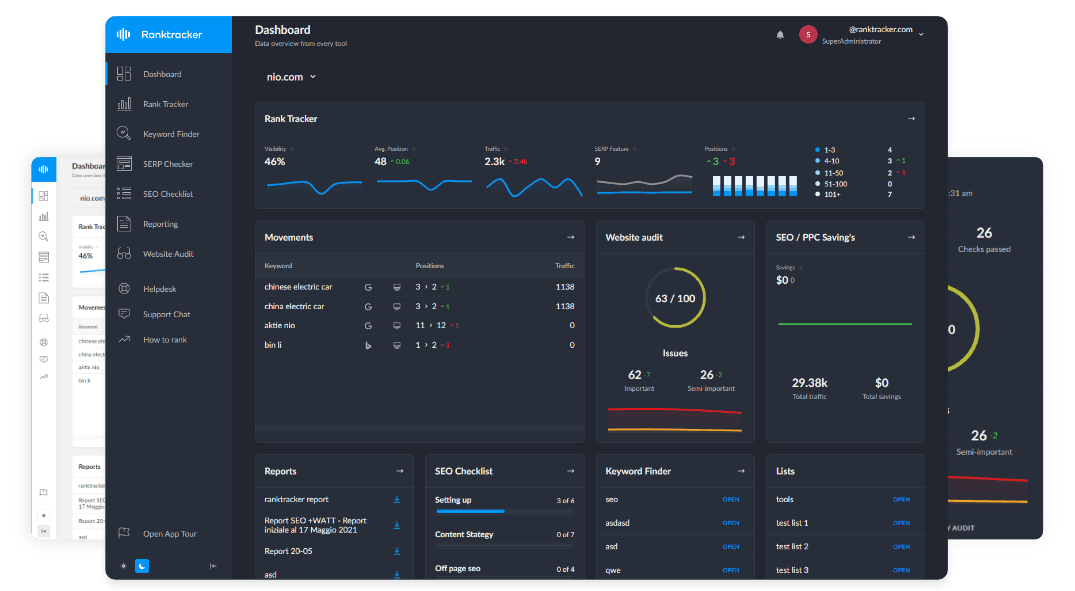Intr
In today’s competitive digital landscape, marketers are swimming in data — keyword rankings, click-through rates, backlink profiles, bounce rates, and more. Tools like Ranktracker provide deep SEO insights, but simply having access to this information isn’t enough.
The real challenge? Transforming raw SEO metrics into clear, actionable reports that inform strategy and drive results. This requires merging multiple datasets, customizing visualizations, and delivering them efficiently to stakeholders.
That’s where SQL Server Reporting Services (SSRS) shines. Traditionally a business intelligence and IT tool, SSRS has become an invaluable asset for marketing teams. By integrating SEO data into a SQL database and visualizing it through SSRS, you can create interactive dashboards, automate report delivery, and get answers to questions your standard SEO dashboards can’t answer.
In this article, you’ll learn why SSRS is such a powerful companion for SEO data analysis, how to integrate it with your existing tools, best practices for SSRS report writing, and real-world examples of how marketing teams are using it to gain an edge.
The Problem with Standard SEO Reporting

Most SEO tools — including Ranktracker, Google Analytics, and Google Search Console — offer built-in reports. These are useful for:
-
Checking keyword position changes
-
Monitoring site visibility
-
Tracking backlinks and organic traffic
But when it comes to strategic decision-making, limitations quickly appear:
- Fragmented Data
SEO data lives in one tool, sales data in another, and campaign spend somewhere else.
- Lack of Customization
Pre-built dashboards often lock you into predefined KPIs and layouts.
- Manual Merging
Weekly reporting often involves downloading multiple files, combining them in Excel, and hoping the data aligns.
- Inefficient Collaboration
Without centralized reporting, different teams might be working from different versions of the truth.
These challenges make it harder to identify the real story behind your SEO numbers.
What Is SQL Server Reporting Services (SSRS)?
SQL Server Reporting Services is a Microsoft platform for creating, deploying, and managing reports. It’s part of the Microsoft SQL Server suite and supports both traditional paginated reports and interactive dashboards.
The All-in-One Platform for Effective SEO
Behind every successful business is a strong SEO campaign. But with countless optimization tools and techniques out there to choose from, it can be hard to know where to start. Well, fear no more, cause I've got just the thing to help. Presenting the Ranktracker all-in-one platform for effective SEO
We have finally opened registration to Ranktracker absolutely free!
Create a free accountOr Sign in using your credentials
With SSRS, you can:
-
Pull in data from multiple sources
-
Apply filters, sorting, and calculations
-
Display reports in tables, charts, maps, or custom visuals
-
Export to PDF, Excel, Word, and more
-
Schedule automated report delivery via email or web portals
In the context of SEO, SSRS gives you the power to go beyond surface-level rankings and see how SEO performance ties into conversions, revenue, and ROI.
Benefits of SSRS for SEO Data Analysis
SSRS offers several competitive advantages for marketers and SEO professionals:
1. Centralized Data Analysis
SSRS allows you to integrate Ranktracker’s SEO metrics with other critical business data — such as CRM leads, PPC spend, or customer lifetime value — to get a holistic view of marketing performance.
2. Custom Visualizations
You control the design of your reports. For example, you could create a multi-layer dashboard showing keyword movement trends, revenue per landing page, and backlink acquisition all in one place.
3. Scalability
Unlike spreadsheets, SSRS handles massive datasets efficiently. Whether you’re tracking 500 or 500,000 keywords, performance remains stable.
4. Automation
Schedule reports to refresh and deliver automatically to stakeholders every day, week, or month.
5. Interactive Features
Add drill-through capabilities so users can click a high-level metric to see its detailed breakdown.
6. Security & Access Control
Control who can view, edit, or share reports, ensuring sensitive business data stays secure.
Advanced Ways SSRS Elevates SEO Analysis
While SSRS can replicate basic SEO dashboards, its real value emerges in advanced scenarios:
-
Merging Ranktracker keyword data with Google Ads spend to see the cost-per-conversion for keywords ranking in the top 3.
-
Correlating content publishing dates with ranking improvements to determine the lag between publishing and ranking gains.
-
Tracking SEO ROI per channel by linking CRM revenue with organic search traffic.
-
Historical trend storage — unlike some SEO tools that limit data retention, SSRS can store years of historical data for long-term trend analysis.
How to Integrate SEO Data into SSRS (Step-by-Step)
1. Data Extraction
Get your SEO data from Ranktracker via:
-
CSV exports
-
Ranktracker’s API for automated pulls
-
Third-party connectors to your SQL Server database
2. Database Setup
Load the data into SQL Server tables. You may also create staging tables for data transformation.
3. Data Transformation
Use SQL queries or ETL (Extract, Transform, Load) tools like SQL Server Integration Services (SSIS) to clean and organize data.
4. Build the Report in SSRS
Use SSRS Report Builder or Visual Studio. Add charts, KPIs, and interactive filters.
5. Automate Delivery
Schedule reports to refresh and send to stakeholders via email or a secure web link.
Real-World Example – Weekly SEO Performance Dashboard
A retail brand’s marketing team needed a report that:
-
Pulled keyword data from Ranktracker
-
Integrated organic traffic data from GA
-
Merged it with sales data from their ERP
They built an SSRS dashboard that:
-
Updated every Monday morning
-
Highlighted the top 10 keywords by revenue impact
-
Flagged keywords with declining rankings for urgent attention
The result: Decision-making time dropped from days to hours, and campaigns were adjusted mid-week instead of waiting for monthly reviews.
Best Practices for SSRS Report Writing
When building SSRS reports for SEO, follow these tips:
- Define KPIs First
Avoid “data dumping.” Choose metrics that directly influence decisions.
- Keep It Simple
Busy executives want clarity, not clutter.
- Optimize Performance
Write efficient SQL queries and index database tables to keep reports fast.
- Use Filters & Drill-Downs
Enable users to self-serve insights without requesting new reports.
- Leverage Professional Expertise
Complex setups are best handled by specialists. Working with experts in SSRS report writing ensures your reports are accurate, performant, and visually effective.
Common Pitfalls to Avoid
-
Overdesigning Reports – Too many visuals reduce clarity.
-
Ignoring Data Quality – Bad data leads to bad decisions.
-
No Refresh Scheduling – Without automation, manual work creeps back in.
-
Forgetting Mobile Users – Many executives check reports on phones or tablets.
When to Hire an SSRS Expert
Consider hiring an SSRS consultant if:
-
Your reports require multiple complex data joins
-
Performance is slow with large datasets
-
Your team lacks SQL and SSRS experience
An expert can help with:
-
Database optimization
-
Report design best practices
-
Implementing automation and security measures
Future of SSRS in Marketing Analytics
With the rise of AI-driven SEO tools and predictive analytics, SSRS will remain a key player as the data visualization and distribution layer. Expect to see:
-
More API-based integrations with SEO platforms
-
AI-assisted anomaly detection in SEO data
-
Integration with Power BI for richer visual storytelling
Conclusion
For marketers who want more than surface-level insights, SSRS is a game-changer. It centralizes SEO data, integrates it with business metrics, and delivers actionable, automated reports that inform strategy.
If you’re ready to move beyond basic dashboards and create data experiences that drive results, SSRS — combined with expert development — is the way forward.

